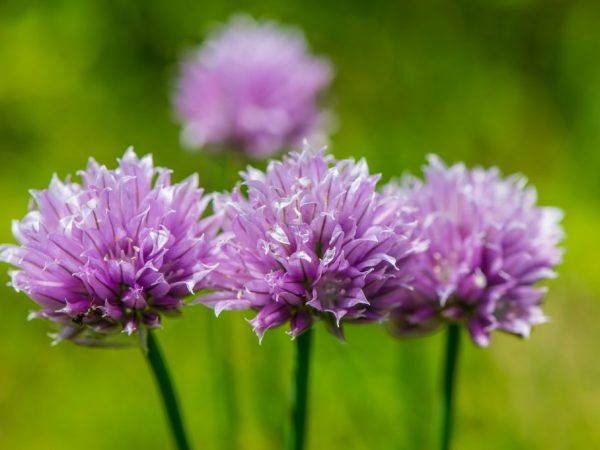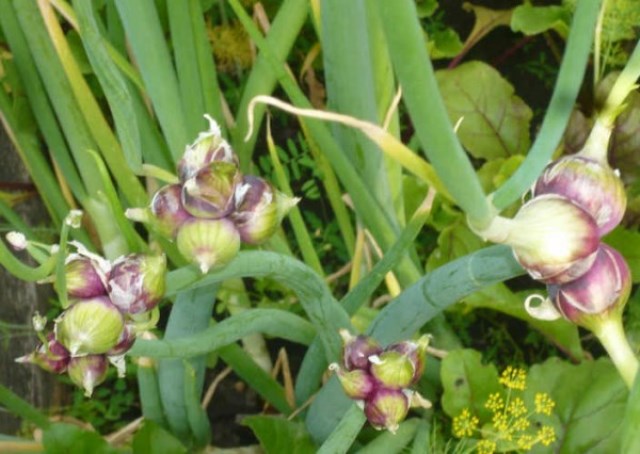Ornamental onions have long been familiar to gardeners, which cannot be said about ornamental garlic. However, this plant is worth attention - it combines high healing and culinary qualities with increased decorativeness. Bright flowers, collected on high arrows, look spectacular and can become an original flower bed decoration.
Description of the plant
The plant can look different depending on the species. All plants have in common - medium-sized flowers collected in inflorescences, soaring above the foliage on the arrows, narrow smooth leaves. Flowering garlic plants are not inferior in decorativeness to bulbous ones, such as pushkinia or daffodils.
Types of decorative garlic:
- Neapolitan. Ornamental garlic of this species is distinguished by small, but clearly distinguishable white flowers, collected in loose openwork inflorescences. In the pictures it strongly resembles wild garlic onion, but in reality it is more decorative. Plant height - 15-16 cm;
- Moli's bow. The botanical name of this species is Allium moly, that is, it can be safely called garlic (in Latin, garlic and onion are Allium). Allium Moli is also called the "golden garlic" for its very bright yellow flowers. The flowers of the Moli garlic have a hue so rich that they evoke associations with a precious metal. The leaves are glaucous, long, 4-5 cm wide, flowers 1 cm in diameter have a stellate shape, collected in inflorescences of 9-15 pcs .;
- Daffodil garlic. Received this name not for the color, but for the shape of the flowers. The drooping heads of bell-shaped flowers 1-2 cm long, lilac-burgundy, are collected in sparse inflorescences of 5-12 pcs. Peduncles are 10-40 cm long. Leaves are narrow, long, up to 20 cm, grow luxuriantly. An unusually graceful plant. Such garlic with purple flowers will bring spring freshness to any composition;
- It does not apply to decorative, but it can become so in especially daring gardeners onion-garlic Rocambol. Its wide large leaves are spectacular, and the yield is impressive - the mass of one head can reach 400 g. This garlic flower is relatively modest. Not bright purple-pink buds are collected in inflorescence balls. They look spectacular, thanks to a peduncle up to 1 m tall. In some sources, Rocambol may be mistakenly called elephant garlic.
How does garlic bloom? Flowering usually lasts about a month. Like any bulbous plant, ornamental garlic is suitable for forcing, so you can get flowers in open or closed ground at any time. Typical flowering periods for different types of ornamental garlic
| Name | When it can bloom, the flowering period |
|---|---|
| Neapolitan garlic | Early June - July, 30 days |
| Garlic Moli | Mid June, blooms for about 30 days |
| Daffodil garlic | From mid-July to early August, bloom lasts up to 35 days |
| Rocambol | July, bloom lasts about a month |
Agrotechnics
Ornamental Garlic Needs:
- Sun-loving. Choose an open, well-lit area. An exception is Moli's garlic, it is able to bloom magnificently even in partial shade and shade. Daffodil tolerates partial shade well;
- The soil must be well-drained, garlic does not like dampness and stagnant moisture;
- Can be planted after legumes, cucumbers, cabbage. Planting after potatoes is undesirable.
Landing rules:
- Place the garlic at a minimum distance of 20 cm from other plants;
- The distance between the teeth is at least 10 cm;
- When growing a plant from seeds, sowing is carried out in late summer and early autumn;
- Before planting, the seeds are soaked in an ash solution (2 tablespoons of wood ash per 1 liter of water), floating to the surface are removed;
- Seed holes - up to 3 cm. Sprinkle with either sand or peat. The cloves are placed in the hole with the sharp end up or placed on one side.
How to care for decorative garlic:
- Watering is of high quality, abundant, but not too frequent, garlic does not like excess moisture. Optimally 2-3 waterings per season. Severe drying out of the soil should also be avoided - this can adversely affect flowering;
- An annual transplant will help you avoid chopping the flowers. Most ornamental garlic can be transplanted once every 3-5 years, when the plantings become too thick and individual plants begin to interfere with each other;
- Other maintenance measures are standard: loosening, removing weeds, fertilizing, promoting flowering and the formation of a high-quality head (wood ash, magnesium sulfate);
- To get large bulbs, the first arrows are cut off;
- Fading inflorescences lose their decorative effect, they are cut off;
- All species reproduce well with baby bulbs. They are separated from the mother plant and planted in May or late August.
In general, decorative garlic is an unpretentious plant. Even with the flaws of care, it is able to please with abundant flowering.
Diseases are rare, but with poor care, ornamental garlic can be affected by neck rot, powdery mildew, onion mites and onion flies. To avoid these problems, thoroughly dry the planting material before storing, avoid waterlogging during the growing season, inspect the plants and remove the affected parts. For onion flies (or ticks), spraying with soap, tobacco or alcohol is effective.
Advantages and disadvantages
The modern assortment of decorative crops is huge. Why choose decorative garlic?
Its pluses:
- Decorative garlic is very beautiful, but can you eat it? The plant can eat. It is an equivalent alternative to regular garlic, only it has a more delicate, subtle taste, more reminiscent of the taste of turnips than garlic. Arrows and fruits are also good food;
- Garlic infusion or water extract can be used as a pest control agent;
- A very wide range of decorative applications outdoors. The plant will decorate a vegetable garden, beds, flower beds, bouquets, alpine slides, and cereal and herb gardens that have been relevant in recent years. Looks beautiful in combination with other perennials or on its own;
- Will replenish the collection of dried flowers - dried inflorescences decorate winter bouquets and compositions;
- Suitable for forcing, can bloom as planned;
- It can be considered as a cut culture - a full-fledged participant in fresh bouquets;
- Various varieties of ornamental onions and garlic make up fashionable onion gardens - allaria;
- It winters well in central Russia. Does not need shelter and digging for the frost period. It is advisable to cover certain species (Moli);
- The plant requires adherence to minimum agricultural techniques.
Minuses:
- In some varieties (Moli's garlic), the leaves begin to wilt during flowering, which slightly spoils the general appearance of the plants;
- Despite the fact that ornamental garlic is edible, it is rarely used in cooking. The plant bulbs are quite small. A striking exception is the Rocambol bow. It is worth planting, first of all, for the sake of huge bulbs that have an unusually delicate, albeit pungent, taste.
The plant looks great on alpine slides, in ridges, where strict geometric shapes are needed. Garlic produces neat and effective borders along the paths. All types of ornamental garlic bloom in summer, when most of the bulbous ones have already faded, its use will refresh the impression of the garden.It goes well with lush garden flowers, especially blues and blues: hydrangeas, delphiniums, irises.














